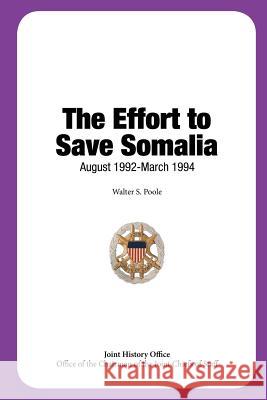The Effort to Save Somalia, August 1992 - March 1994 » książka
The Effort to Save Somalia, August 1992 - March 1994
ISBN-13: 9781480200074 / Angielski / Miękka / 2012 / 108 str.
In shaping policy towards Somalia, the Chairman of the Joint Chiefs of Staff, the Vice Chairman, and the Joint Staff had to advise how US military forces could execute an evolving range of missions "other than war" humanitarian relief and suppression of banditry, followed by peace enforcement with international forces under United Nations (UN) command, all accompanied by a nation-building effort. The experience of the Vietnam War, where US military involvement deepened while political goals remained misty, shaped their thinking. From the beginning, these officers sought a definition of the political goals or "end-state" in Somalia. Yet, despite their efforts, US objectives underwent repeated change. Press images of a massive famine provoked US intervention in Somalia. Severe drought destroyed local crops and famine resulted when marauding gangs seized food and blocked the distribution of relief supplies. Minimizing risks for US forces by confining them to ensuring the flow of aid also meant minimizing their role in political reconciliation and reconstruction. On the other hand, widening US military missions could further the attainment of political objectives but risked American casualties. Such losses eventually did turn public opinion against continued US involvement there. In August 1992, as C-130s began an airlift of relief supplies, the Joint Staff warned about the danger of being drawn into an open-ended commitment. The State Department, on the other hand, recommended committing US ground troops to guard food distribution facilities at "points of security." The Joint Staff warned against such a "long-term commitment of resources in a no-win situation," and the Deputies Committee (DC) of the National Security Council (NSC) chose to seek UN forces for such tasks. Written several years after the end of operations by US forces in Somalia, this monograph focuses specifically on the involvement of the Chairman of the Joint Chiefs of Staff and the Joint Staff in planning and directing the operations in Somalia from August 1992 to March 1994. The study begins with a discussion of the conditions and circumstances that, in August 1992, led President George H. W. Bush to direct the American military to support relief efforts in Somalia and ends with the final withdrawal of US forces in 1994.
Zawartość książki może nie spełniać oczekiwań – reklamacje nie obejmują treści, która mogła nie być redakcyjnie ani merytorycznie opracowana.











